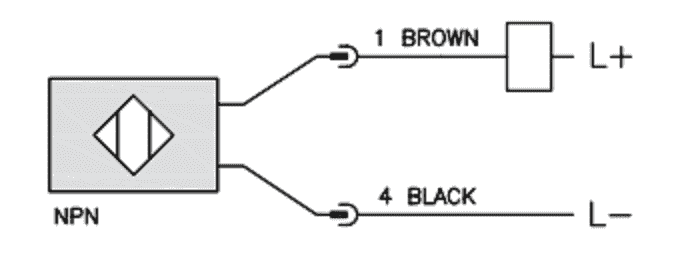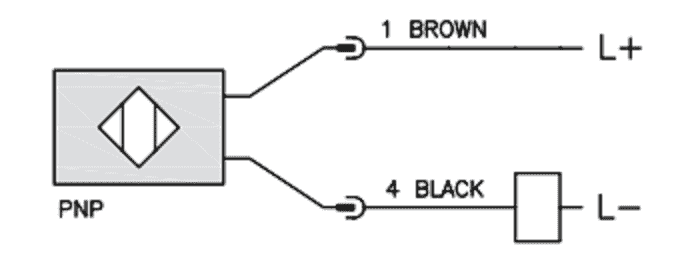We will now look at wiring an NPN and PNP inductive proximity sensor to the Click PLC. A proximity sensor (switch) is able to detect object presence without physical contact like a limit switch. No physical contact means that the switch has no parts that will wear out. The life span of the sensor is increased with less maintenance.
An inductive proximity sensor will detect ferrous metals. The sensor develops an electric field when metal (sensing object) is introduced usually killing the oscillation circuit of the sensor triggering the output.
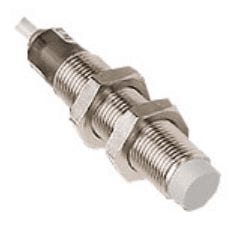
We will be wiring an inductive proximity switch into the input of our Click PLC. The AM1-A0-4A is an extended range 12mm tubular sensor that can be wired into the PLC as a sink or source input. Let’s get started.
Additional discrete component connections to PLC include the following:
Here’s a Quick Way to Wire NPN and PNP Devices
– Wiring NPN Sensor to PLC Video
– Wiring PNP Sensor to PLC Video
– Wiring Contact Discrete PLC Inputs Video
Wiring Interposing Relays
– Wiring NPN and PNP Sensors into the PLC with an Interposing Relay Video
Click PLC HMI Rotary Encoder Dial Input – Video
Wiring Stack Light to Click PLC – Video
Wiring Push Buttons and Selector Switch to Click PLC – Video
– Test and Assembly of Push Buttons and a Selector Switch – Video
Watch the video below to see the wiring of sinking and sourcing to the Click PLC with the 2 wire proximity switch.
AM1 Series Sensors – Extended Sensing Distance (12mm) Features
This proximity sensor has sink/ source, selectable wiring models.
– Sink/ source 2-wire or NPN and PNP 3-wire models
– Metal housing
– Axial cable or M12 quick-disconnect models
– Complete overload protection
– LED status indicator
– DC powered
– 4mm shielded and 8mm unshielded extended sensing distances
– 2-wire models work with sinking or sourcing PLC input modules, have very low leakage current
– IEC IP67 protection rating
– Lifetime warranty
AM Series Inductive M12 specifications
Inductive Proximity Sensors
When looking at proximity sensors here are some terms that you need to understand.
Shielded and Unshielded types affect the mounting and distance that the sensor can detect.
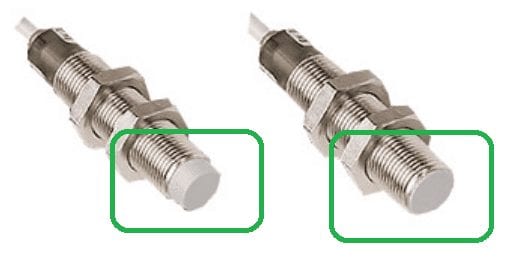
Our sensor on the left is an unshielded sensor. You will notice that the threads stop before the end of the sensor. This will allow a larger surface area for the sensor to detect the object, therefore, the range is greater. In our case our AM1-A0-4A sensing range is 8mm. The AM1-A0-3A on the right is a shielded sensor. This sensor can be flush mounted with metal which can help protect the sensor from physical damage. The sensing range (4mm) is half that of the unshielded.
Switching Frequency
This is indicated in the specifications above and is expressed in Hertz. Hertz is a measurement of pulses per second. In our case, our 2 wire extended distance sensor 750Hz. (750 times a second). In general, the larger the proximity sensor the slower the response. Also, two-wire sensors have lower switching frequencies then three wire sensors.
Leakage Current (Off – State)
2 wire sensors usually have large leakage current compared to 3 wire sensors. In our case, low leakage current this is one of the features of this AM Series Inductive Proximity Sensor. (3-wire: >=120µA / 2-wire: >=0.8mA)
Short Circuit Protection
This will protect the sensor from incorrect wiring. I have seen many 2-wire sensors that are destroyed because no load was placed on them before connecting. This usually happens right out of the box when the two terminals are connected directly to a power supply. This is another great feature of this AM series.
Wiring our Sink/Source Input to the Click PLC

You can see that the inputs of the click can be wired with the common at +24VDC or 0VDC. The input of the PLC will act as the load for our proximity sensor.

NPN Wiring
This is sometimes referred to as sinking the load or negative switching. The black wire of our sensor is connected to the 0VDC supply. The common point of the PLC input is connected to the 24VDC supply and the brown wire of our sensor is connected to the PLC input. You can see that when the proximity switches, the sensor then connects the load to OVDC.

PNP Wiring
This is sometimes referred to as sourcing the load or positive switching. The brown wire of our sensor is connected to the 24VDC supply. The common point of the PLC input is connected to the 0VDC supply and the black wire of our sensor is connected to the PLC input. You can see that when the proximity switches, the sensor then connects the load to 24VDC.
Watch the video below to see the wiring of our 2-wire sensor each way into our Click PLC.
Click PLC Program

We will use a simple program in our Click PLC. When the normally open input (X1) proximity sensor is made, the output Y1 turns on.
Monitoring the Click PLC Inputs and Outputs
If the PLC is in a panel and you cannot see the actual inputs and outputs (IO) there is a way to see the status lights. System Monitor is used to doing just that through the Click PLC software.
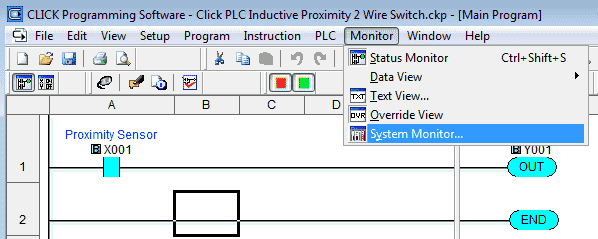
System Monitor can be accessed through the main menu | Monitor | System Monitor…
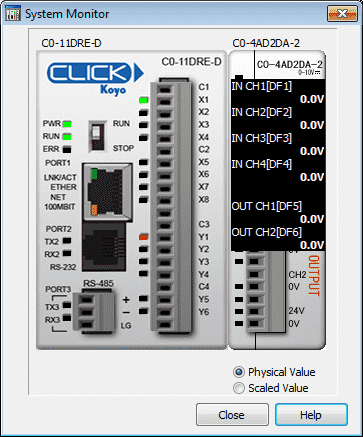
As we run our program the status of the PLC can be monitored.
Please watch the video below to see the wiring and operation of the inductive proximity switch with the Click PLC.
Download the Click PLC program here.
AM1-A0-4A Purchase
AM Series Inductive Proximity Sensor Specifications
Proximity Sensor Terminology
Sensors Frequently Asked Questions (FAQ)
Watch on YouTube: Wiring an Inductive Proximity NPN PNP Sensor to the Click PLC
Here is some additional information on wiring PLC inputs.
Wiring NPN Sensor to PLC
https://youtu.be/Z09l3HKMpqs
https://accautomation.ca/heres-a-quick-way-to-wire-npn-and-pnp-devices/
Wiring PNP Sensor to PLC
https://youtu.be/nP33k5e_Y-k
https://accautomation.ca/heres-a-quick-way-to-wire-npn-and-pnp-devices/
Wiring Contact Discrete PLC Inputs
https://www.youtube.com/watch?v=xh5dE2Z09d0
https://accautomation.ca/how-plc-inputs-work/
Wiring Stack Light to Click PLC
https://accautomation.ca/wiring-stack-light-to-click-plc/
https://youtu.be/gwDIVtNSXfs
If you have any questions or need further information please contact me.
Thank you,
Garry
If you’re like most of my readers, you’re committed to learning about technology. Numbering systems used in PLC’s are not difficult to learn and understand. We will walk through the numbering systems used in PLCs. This includes Bits, Decimal, Hexadecimal, ASCII and Floating Point.
To get this free article, subscribe to my free email newsletter.
Use the information to inform other people how numbering systems work. Sign up now.
The ‘Robust Data Logging for Free’ eBook is also available as a free download. The link is included when you subscribe to ACC Automation.


